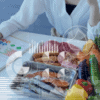At some point you’ve probably heard someone say “that’s bad food”. In reality there is no bad food. There is food that is great for you, there is food that is good for you, and there is food that is not so good for you. I like to tell people try to eat your food as close to the source as possible. With the exception of meat, unless you want to cut your steak into the shape of a cow, I mean be my guest. Your food should look like it just came out of the ground or off a tree or bush. The closer it resembles that, the better it is for you. When our food gets processed a lot of micronutrients get striped from it. You’re likely to see “added vitamin d” or “added calcium” on the packaging. Here’s another tip that’s kind of obvious but if it’s in a manufactured package stay away from it, it’s processed. I’m not talking about a plastic bag or wrapping to keep it clean.
Food is information to your bodies.
When we eat food, we are telling our bodies what to do and what not to do. Essentially sending it instructions to kick off certain processes like make hormones, trigger immune cells, switch these genes on, or switch those genes off. This is where the “addiction” can come in. I put it in quotes because that’s a naughty word. Most people get a lot of push back when you mention the fact that you can get addicted to food, they say that’s not possible. Yet here we are fighting eating disorders all the time. It you want to put it in a class then yes food addiction is on the lower end of the spectrum. But it can be a very bad addiction for some people. Most people will deny the fact that they are addicted to certain foods. They either have high confidence in themselves that they can “just stop whenever they want to”, or don’t believe there is an issue. Sugar is the main perperator when it comes to what part of the carbohydrate people are addicted to.
Now let us talk about carbohydrates.
When we eat carbohydrates, and it does not matter what kind, our blood sugar goes up. Our body breaks down almost all carbohydrates and can even turn protein into glucose. Glucose then carries the messages to tell your gut to release some molecules like gastric inhibitory polypeptide (GIP) and glucagon-like peptide-1 (GLP-1). These then carry a message to the pancreas and tell it to release the hormone insulin. That’s when insulin then tells the rest of your body to prepare for the glucose it’s about to receive. Your pancreas also releases some other things like amylin and somatostatin that tell your brain you’ve got food!
Hopefully you get the picture now that food is more like information. The more carbohydrates you eat the more glucose you make and the more insulin gets released. This can send your body on an insulin roller coaster. If you do this, enough times your body starts to need more insulin to carry that message. This can lead to insulin resistance and the “need” to have more carbohydrates to ilicit the same response.
Click here to calculate your daily carb intake . Click here for more about carbohydrates
What about “good carbs” and “bad carbs”?
“Good carbs” means the food usually is high in fiber. Having more fiber means, it takes your body a little longer to break down for energy. Things like fruits, vegetables, and whole grains are naturally high in fiber “good” carbs.
“Bad carbs” refers to foods that contain as refined carbohydrates, and usually lower in fiber. Mainly speaking of processed white flour and sugar.
Good carbohydrates (High fiber content)
- Slowly digested (body can use food as energy over several hours). Slowly digested foods result in a gradual increase in blood sugar.
- Unprocessed foods. Natural ingredients are not removed during the making of the food. Examples include whole grain breads, beans, cereals, and products made from whole-wheat flour, along with vegetables and fruits.
- Helps reduce the risk of heart disease and diabetes; helps prevent obesity; and keeps the digestive system healthy
Bad carbohydrates (Low fiber content)
- Rapidly digested. Rapidly digested foods cause a spike in the level of blood sugar (The spike triggers the pancreas to make more insulin, which is a hormone that makes the body store more fat.)
- Processed foods. Natural ingredients have been removed or changed during the making (the ‘processing’) of the food. For example, to make white bread, the bran and germ from wheat grain needs to be removed to make the white flour used to make white bread. Other processed food include cakes, cookies and other bakery items made with white flour; white (processed) rice and some cereals.
- Increases the risk of heart disease, diabetes, and obesity.
Below are some good sources of carbohydrates:
| Food | Carb (grams) |
| 1 cup (133g) sweet potato | 27 |
| 1 med (118g) Banana | 27 |
| 1 cup cooked white rice | 47 |
| 1 granny smith apple (154g) | 22 |
| 1 cup chopped raw carrots | 7 |
| 1 cup cooked whole wheat pasta | 41 |
| 1 cup cooked pasta | 8 |
| 1 scoop Vitargo (carb powder) | 35 |
| 100g raw strawberries
1 cup of corn 1 cup of cooked oatmeal |
8
32 54 |
| Source: USDA National Nutrient Database, 2015 | |





